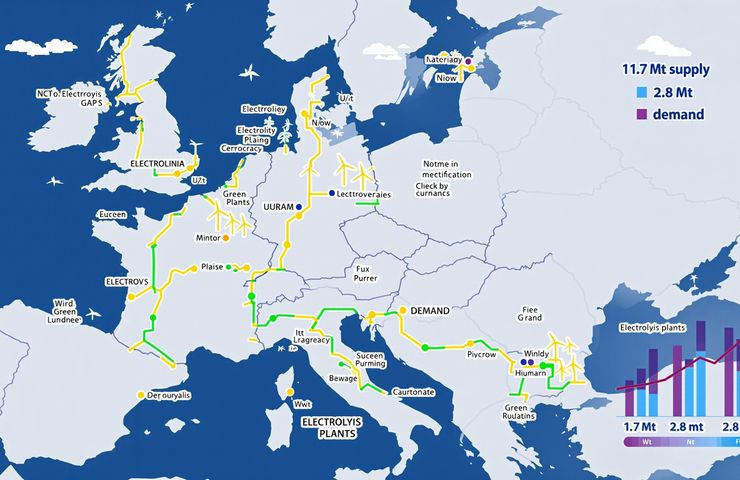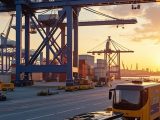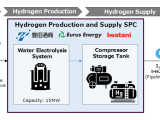
EU Green Hydrogen Production Faces 1.1Mt Shortfall by 2030
October 1, 2025The EU’s looking at a pretty big shortfall in green hydrogen. Industry forecasts say domestic hydrogen production will hit about 1.7 million tonnes a year by 2030, but demand is set to soar to 2.8 million tonnes thanks to ambitious industrial decarbonization goals for heavy industry, transport and power. Hydrogen Europe, the industry’s top lobby group, is warning that without firm quotas, speedy permitting, and robust market incentives, Brussels is in danger of missing its own targets—and that could unravel the EU Green Deal and REPowerEU plans.
Market Implications
That 1.1 Mt gap isn’t just a number. Europe’s push to decarbonize steel mills, refineries, and chemical plants hinges on having a steady, homegrown supply of green hydrogen. If that supply dries up, industries might drift toward pricier low-carbon options—or worse, slip back to grey hydrogen. That would throw a wrench in the EU’s plan to hit carbon neutrality by 2050.
On the money side of things, investors are getting jittery. Banks want predictable offtake agreements and clear policy signals before greenlighting big electrolyzer projects. Without those, you won’t see bankable contracts, and plenty of gigawatt-scale plans could stall. Regions like the Ruhr, Dunkirk, and Rotterdam could lose their competitive edge if feedstock costs spike.
And it’s not just the big players—smaller plants would scramble too, hunting for reliable feedstock or budgeting for pricier backups.
Infrastructure Bottlenecks
On top of the supply squeeze, Europe’s hydrogen infrastructure needs a serious boost. The 2024 ENTSOG TYNDP report lays out key corridors for pipelines, but the actual build-out is lagging. Permitting delays for cross-border lines and repurposed gas networks are holding back volumes from reaching major industrial hubs.
Then there’s the grid challenge: wind-rich areas are brimming with potential for electrolyzers, but high renewable power prices in Europe—higher than in many other markets—are pushing producers to eye cheaper electricity from abroad, which only slows down onshore capacity growth.
Storage adds its own headache: current tanks only buffer short-term swings, and expanding facilities takes time and cash. Hydrogen refueling stations for trucks are also sparse, making fleet operators hesitate to switch.
Competitive Landscape
Don’t forget the global competition. The US Inflation Reduction Act throws big tax credits at hydrogen production, and Australia’s export projects are locking in long-term deals that undercut European costs. North African solar-powered electrolysis setups are lining up shipping routes to European ports, promising 24/7 deliverability at fixed prices.
Point is: if Europe doesn’t sharpen its incentives and simplify the rulebook, it’s handing market share—and jobs—to overseas players.
Plus, overseas projects are luring European talent—developers and researchers alike. Losing that know-how could slow Europe’s clean sustainable energy progress.
Technical Snapshot: Electrolysis Scale-Up
Electrolyzer makers say Europe needs to crank up to at least 40 GW of capacity by 2030—more than three times what’s on the books now—to meet the 10 Mt production goal. That means:
- Locking in large-scale renewable power purchase agreements to drive down electricity costs.
- Fast-tracking permits with a one-stop shop model across member states.
- Deploying modular electrolyzers near industrial clusters to slash grid and pipeline CAPEX.
And remember, we need skilled crews and steady supply chains for membranes, catalysts and other electrolyzer essentials.
Key Takeaways
- Domestic green hydrogen output will hit only 1.7 Mt by 2030, against a demand of 2.8 Mt.
- Without binding quotas and harmonized rules, the 1.1 Mt gap remains wide open.
- Pipeline, storage, and grid build-out are falling behind policy ambitions.
- Imports from the US, Australia, and North Africa could fill part of the hole—but shift economic benefits offshore.
- Hitting the 10 Mt target means a radical speed-up in electrolyzer roll-out and solid financing certainty.
Urgent Policy Action Needed
If Europe wants to avoid a shortfall, EU institutions need to:
- Set binding green hydrogen quotas for each member state, tied to their national energy transition plans.
- Cut approval times by 50% with an EU-wide one-stop shop for permitting.
- Guarantee offtake through public-sector purchase obligations and dedicated contract-for-difference (CfD) schemes.
- Direct targeted grants and concessional loans to electrolyzer manufacturers and project developers.
If these steps don’t happen, Europe risks meeting just two-thirds of its needs—derailing industrial decarbonization, exposing itself to volatile import prices, and ceding leadership in clean sustainable energy.
Europe still holds the cards on policy and financing. It’s time to play them.



 With over 15 years of reporting hydrogen news, we are your premier source for the latest updates and insights in hydrogen and renewable energy.
With over 15 years of reporting hydrogen news, we are your premier source for the latest updates and insights in hydrogen and renewable energy.
Can Geologic (Gold/White) H2 not bridge the gap?